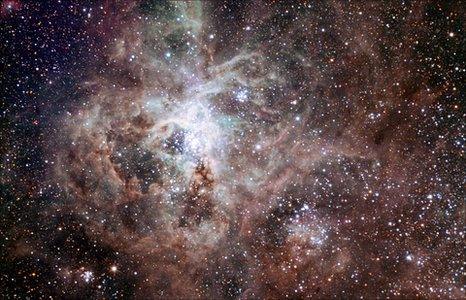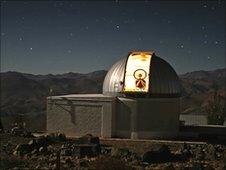New robotic telescope in Chile set for planet hunt
- Published

The absence of dust from the Tarantula nebula makes it a good observing target
A new robotic telescope designed to study planets around other stars has taken its first image.
Although based in Chile, the Trappist telescope will be operated from a control room in Belgium, 12,000km away.
As well as detecting and characterising so-called exoplanets, Trappist will also study comets orbiting our Sun.
The 0.6m fully-automated telescope will be based at the La Silla Observatory, on the outskirts of Chile's Atacama Desert.
"Terrestrial planets similar to our Earth are obvious targets for the search for life outside the Solar System," said Emmanuel Jehin, one of the astronomers on the project.
"Comets are suspected to have played an important role in the appearance and development of life on our planet."
The telescope's stunning first image shows the Tarantula Nebula, located in the Large Magellanic Cloud (LMC) - one of the galaxies closest to our own.

Trappist is a relatively lightweight telescope
The nebula - which measures 1,000 light-years across - owes its name to the arrangement of bright patches, which have been likened to the legs of a tarantula.
Trappist (TRAnsiting Planets and PlanetesImals Small Telescope) will study exoplanets by measuring at high precision the "brightness dips" that can be caused by objects transiting (passing in front of) their parent star.
During such a transit, the observed brightness of the star drops slightly because the planet blocks a part of the starlight.
The larger the planet, the more of the light is blocked and the more the brightness of the star will fall.
The telescope is operated by the European Southern Observatory (Eso) organisation, which oversees the La Silla facility and the Very Large Telescope (VLT), which is also in Chile.
Trappist will join two other planet-hunting instruments at La Silla: known as Harps and Coralie.
"Eso's La Silla Observatory on the outskirts of the Atacama Desert is certainly one of the best astronomical sites in the world," said Michael Gillon, who leads the exoplanet survey for Trappist.
"And because it is already home to two superb exoplanet hunters, we couldn't have found a better place to install our robotic telescope."
The new instrument is equipped with special filters which will enable astronomers to study regularly and in detail the ejection of several types of molecules by comets during their journey around the Sun.